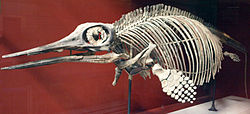Ophthalmosaurus
| Ophthalmosaurus | |
|---|---|

| |
| O. icenicus skeleton at the Natural History Museum, London, with the forelimbs mounted backwards[1] | |
| Scientific classification | |
| Domain: | Eukaryota |
| Kingdom: | Animalia |
| Phylum: | Chordata |
| Class: | Reptilia |
| Order: | †Ichthyosauria |
| Family: | †Ophthalmosauridae |
| Subfamily: | †Ophthalmosaurinae |
| Genus: | †Ophthalmosaurus Seeley 1874 |
| Type species | |
| †Ophthalmosaurus icenicus | |
| Species | |
| |
| Synonyms | |
| |
Ophthalmosaurus (Greek ὀφθάλμος ophthalmos 'eye' and σαῦρος sauros 'lizard') is a genus of
Description
Ophthalmosaurus was a medium-sized ichthyosaur, growing to measure 4 m (13 ft) in length and weighing between 930–950 kg (2,050–2,090 lb).
Discovery and species
Ophthalmosaurus was first described by
However, more recent
Ophthalmosaurus natans was described as Sauranodon, then later renamed to Baptanodon by Marsh in 1880. However this decision was questioned not long afterwards with Baptanodon instead being considered an American species of Ophthalmosaurus. Recent analysis have recovered the species as closer to other ophthalmosaurines than to the Ophthalmosaurus type species,[7][9][17] suggesting that the previous name should be reinstated. Similarly, Ophthalmosaurus chrisorum, whose holotype has been recovered in Canada and described by Russell in 1993, was moved to its own genus Arthropterygius in 2010 by Maxwell.[18]
While primarily known from the Jurassic, material from the
Classification

Within
Phylogeny
The cladogram below follows Fischer et al. 2012.[9]
| Thunnosauria |
| ||||||||||||||||||||||||||||||||||||||||||||||||||||||||||||||||||||||||
The following cladogram shows a possible phylogenetic position of Ophthalmosaurus in Ophthalmosauridae according to the analysis performed by Zverkov and Jacobs (2020).[12]
Ophthalmosauria
|
| ||||||||||||||||||||||||||||||||||||||||||||||||||||||||||||||||||||||||||||||||||||||||||||||||||||||||||||||||||||||||||||||||||||||||||||||||
Palaeobiology
Ophthalmosaurus icenicus possessed small teeth with robust tooth crowns and signs of slight wear differing notably from the robust teeth of later species of Platypterygius, known to have hunted large prey including turtles and birds, and the minute teeth of Baptanodon, interpreted to be a soft prey specialist. Fischer et al. (2016) conclude that this intermediary tooth morphology indicates that Ophthalmosaurus icenicus was most likely a generalist predator, feeding on a variety of smaller prey items.[22]
Ophthalmosaurus could likely dive for around 20 minutes. Assuming a conservative cruising speed of 1 metre per second (3.3 ft/s) (2 metres per second (6.6 ft/s) being more likely), Ophthalmosaurus could reach depths of 600 metres (2,000 ft) or more during a dive, reaching the mesopelagic zone.[3] However, while studies on the biomechanics of Ophthalmosaurus suggests that such feats could be physically achieved, studies on the environment of the Peterborough member of the Oxford Clay suggest that Ophthalmosaurus instead inhabited relatively shallow waters there, being determined to have been just 50 metres (160 ft) deep at a distance of 150 kilometres (93 mi) from the shore.[23]
See also
- List of ichthyosaurs
- Timeline of ichthyosaur research
References
- S2CID 133288616.
- ^ S2CID 5432366. Archived from the original(PDF) on 18 January 2017.
- ^ S2CID 54742104. Archived from the original(PDF) on 2019-07-07.
- PMID 11855367.
- S2CID 129725722.
- ^ Maisch MW, Matzke AT. 2000. The Ichthyosauria. Stuttgarter Beiträge zur Naturkunde, Serie B (Geologie und Paläontologie) 298: 1-159.
- ^ ]
- ^ S2CID 86036325.
- ^ PMID 22235274.
- ^ ISBN 9780521545822.
- ^ N. G. Zverkov, M. S. Arkhangelsky and I. M. Stenshin (2015) A review of Russian Upper Jurassic ichthyosaurs with an intermedium/humeral contact. Reassessing Grendelius McGowan, 1976. Proceedings of the Zoological Institute 318(4): 558-588
- ^ .
- ^ McGowan C, Motani R. 2003. Ichthyopterygia. – In: Sues, H.-D. (ed.): Handbook of Paleoherpetology, Part 8, Verlag Dr. Friedrich Pfeil, 175 pp., 101 figs., 19 plts; München
- ^ a b Michael W. Maisch (2010). "Phylogeny, systematics, and origin of the Ichthyosauria – the state of the art" (PDF). Palaeodiversity. 3: 151–214.
- S2CID 45794618.
- ISSN 0895-9811.
- S2CID 132955874.
- S2CID 85143039.
- PMID 22235274.
- ^ Fernández M. 2007. Redescription and phylogenetic position of Caypullisaurus (Ichthyosauria: Ophthalmosauridae). Journal of Paleontology 81 (2): 368-375.
- ^ Arkhangel’sky, M. S., 1998, On the Ichthyosaurian Genus Platypterygius: Palaeontological Journal, v. 32, n. 6, p. 611-615.
- PMID 26953824.
- S2CID 129388168.
